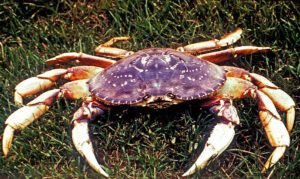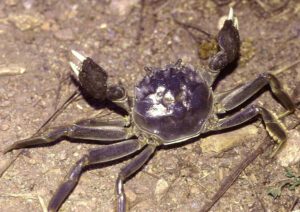The Blue crab is a species of crab which is native to the waters of the western Atlantic Ocean and the Gulf of Mexico. And it has also introduced internationally.
It is known by many other different names such as Atlantic Blue crab, and regionally known as the Chesapeake Blue crab.
It has introduced in the Eastern Atlantic, in the northern and eastern Mediterranean and also in Japan. Read some more information about this crab species below.
Blue Crab Characteristics
The carapace of the Blue crab is wider than long. The front bearing 2 obtuse to acuminate, broadly triangular teeth with sinuous inner margins longer than outer margins.
9 anterolateral, acuminate teeth, the larger one at the lateral corner long and sharp-pointed, and having a dorsal carina produced to the metagastric area; telson lanceolate, longer than wider.
The male and female Blue crabs are easily distinguished from each other. They are easily distinguished by the shape of the abdomen, and by the color differences in the chelipeds or claws.
The abdomen is wide and rounded in mature females, but is long and slender in males. The immovable, fixed finger of the claws in males is blue with red tips, while the females have orange coloration with purple tips.
The abdomen of the females change as they mature, and the immature females have a triangular-shaped abdomen but the mature females have rounded abdomen.

The male Blue crabs may also have mottled white coloration on the swimming legs, and the females have areas of violet coloration on the internal surface of the claws. They can grow to a carapace width of around 23 cm. Photo and info from Wikipedia.
Diet
The Blue crabs are non-selective feeders. Their common foods include clams, oysters, fishes, other benthic invertebrates, and plant material and also detritus and carrion.
Breeding
The spawning and mating are distinct events in Blue crab reproduction. The females mate only once in their lifetime during their pubertal, or terminal, molt.
But the males may mate several times and undergo no major changes in morphology during the process. These crabs have high fecundity.
The females can produce up to 2 million eggs per brood. The females generally migrate to high salinity waters during spawning to develop a sponge, and return inland after hatching their larvae.
Uses
The Blue crab is mainly utilized for food. It is very tasty and popular around the globe.
Special Notes
The Blue crab is of significant culinary and economic importance in the United States (particularly in Chesapeake Bay, New Jersey, Louisiana and North Carolina).
It is the Maryland state crustacean and is that state’s largest commercial fishery.
Growth rate of this crab is faster, and they reach marketing size earlier. Their maximum lifespan is 3 years.
Meat of these crabs is very tasty and very popular. However, review full breed profile of this crab in the table below.
| Name | Blue Crab |
| Kingdom | Animalia |
| Phylum | Arthropoda |
| Class | Malacostraca |
| Order | Decapoda |
| Family | Portunidae |
| Genus | Callinectes |
| Species | C, sapidus |
| Binomial Name | Callinectes sapidus |
| Other Names | Atlantic Blue crab, Chesapeake Blue crab |
| Breed Purpose | Food |
| Special Notes | Commercially important through it’s native range, is of great economic importance in the United States, grow relatively faster, reach marketing size earlier, maximum recorded lifespan is 3 years, meat is very tasty and popular, used mainly for food |
| Breeding Method | Natural |
| Climate Tolerance | Native climate |
| Body Color | Grayish, bluish to brownish green dorsally |
| Rarity | Common |
| Availability | Western Atlantic |






